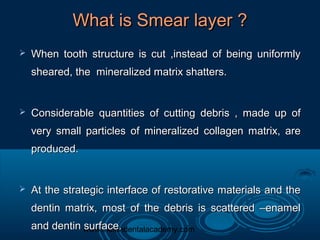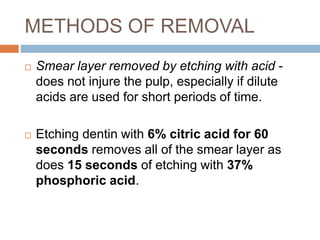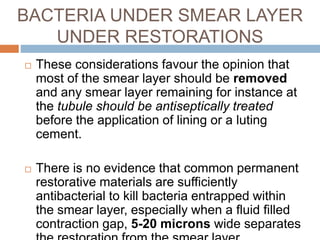Which Material Removes the Smear Layer During a Restorative Process
SODIUM HYPOCHLORITE AND EDTA The purpose of irrigation is two fold. DENTIN CONDITIONER This is the polyacrylic acid solution designed to remove the smear layer from dentin for improved bonding of GI restorative lining and build up materials.
Area is rinsed for aprox.

. Etching removes the smear layer opening the. Then the bonding component is allowed to flow into these small defects and into the partially opened tubules. Citric acid is used as a component in MTAD and Tetraclean the combination products for smear layer removal.
Generation adhesive systems is a three-step process. Should take 20-60 seconds. This thin 1-2 microns layer of denatured cutting debris is very tenacious and is often the surface to which restorative materials are.
The bonding mechanism of the fourth-. For dentin after applying 3040 phosphoric acid the smear layer is completely removed and the underlying dentin is demineralized exposing dentin collagen 1. In the MTAD preparation citric acid helps remove the smear layer by allowing the doxycycline to enter the dentinal tubules and exert an antibacterial effect.
Malic acid showed the greatest significant reduction in dentin microhardness P 005 followed by EDTA MTAD NaOCl and saline control. -etching w phosphoric acid dissolves smear layer first then portions of the hydroxyapatite crystals from dentin surface this opens the dentinal tubules. Request PDF Smear layer in Restorative Dentistry and Endodontics Unknown and unrecognized for years the smear layer has become a force to be.
The etch-and-rinse approach requires a separate step of applying phosphoric acid to demineralize the smear layer and tooth structure. Citric acid is more potent than EDTA. The tooth surface receives the etchant material which removes the smear layer.
First HAp is removed by acid etching leaving the collagen molecules exposed. Which material is being applied by the assistant in this procedure. For this application I add rubbing alcohol to flour of pumice and using a prophy cup clean all of the tooth surfaces to remove the uncured resin layer.
Which compound is an etchant that is used to remove the smear layer during a restorative process. To remove gross debris originating form pulp tissue Mc Comb and Smith 1975 compared the efficacy of 20 polyacrylic acid with REDTA and found that it was no better than REDTA in removing or preventing the build up of smear layer probably owing to its higher viscosity Mc. The smear layer is made up of tooth particles ranging from less than 05 µm to 15 µm.
Remaining Dentinal Thickness SIGNIFICANCEn Amount of RDT underneath tooth preparation plays most important role in the incidence of a pulp response n In teeth dentin is approx 3 mm thick n RDT of more than 2 mm adequate. In the second step a polymeric resin is applied to the surface. This resin infiltrates the collagen layer and penetrates into the dentinal tubules of the underlying dentin which are open because the smear layer was removed by the acid etching.
Etching Gel is a phosphoric acid etchant used for etching enamel and dentin to promote adhesion of primerbonding agent adhesives to tooth structure and restorative materials. In the situation where the smear layer is left behind on the teeth following a bonding procedure or the fabrication of a direct provisional alcohol is still the answer. During a dental procedure a dental assistant uses a high-velocity evacuator to remove the oral fluids so that the dental material does not traumatize oral soft tissues in the mouth.
Additionally what is dental etching gel. 1 condition 2 prime and 3 bond. The particles are composed of globular subunits approximately 005 01 µm in diameter which originated.
Its deep blue tint thin viscosity allow for easy placement and visibility on the tooth surface. N Dentin permeability increases with decreasing RDT n At. Once this material is placed it will be allowed 1 to harden and act as a hybrid layer or 2 to remain in a liquid state while the restoration is being placed to bond together the tooth and the.
The smear layer is created on hard tissues of the teeth whenever they are cut with hand or rotary instruments. -dentin has higher-water content contains collagen and other fluids from pulp chamber. The literature has shown that the addition of conditioner which is diluted polyacrylic acid 20 percent by weight removes the smear layer and has minimal etchant effect.
3 The presence of a smear layer may also interfere with the action and effectiveness of root canal irrigants and interappointment disinfectants. 20 Questions Show answers. PULP RESPONSE TO RESTORATIVE MATERIALS.
When the smear layer is not removed it may slowly disintegrate with leaking obturation materials or it may be removed by acids and enzymes that are produced by viable bacteria left in the tubules or that enter via coronal leakage. Etching of dental enamel with acid removes the smear layer and opens enamel tubules. 10 seconds to remove etch material.

Pdf The Smear Layer In Endodontic To Keep Or Remove An Updated Overview

Smear Layer Certified Fixed Orthodontic Courses By Indian Dental Aca


Comments
Post a Comment